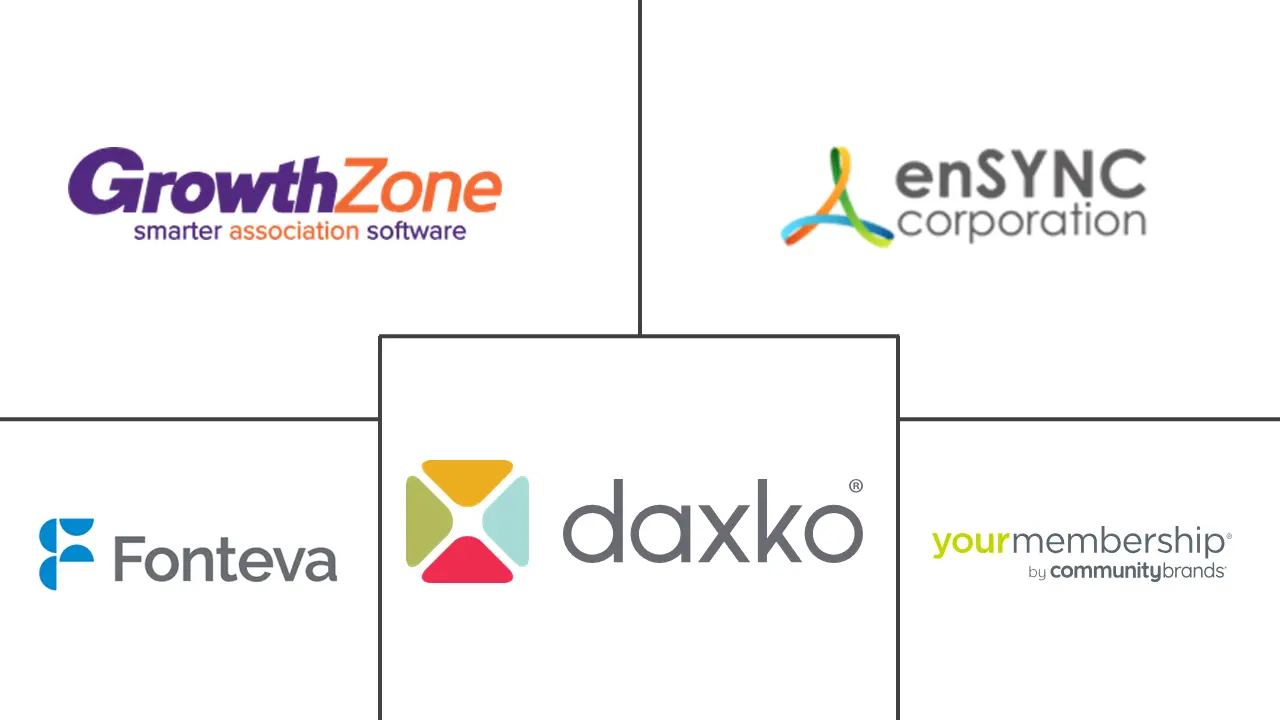Association Management Software Market Size and Share
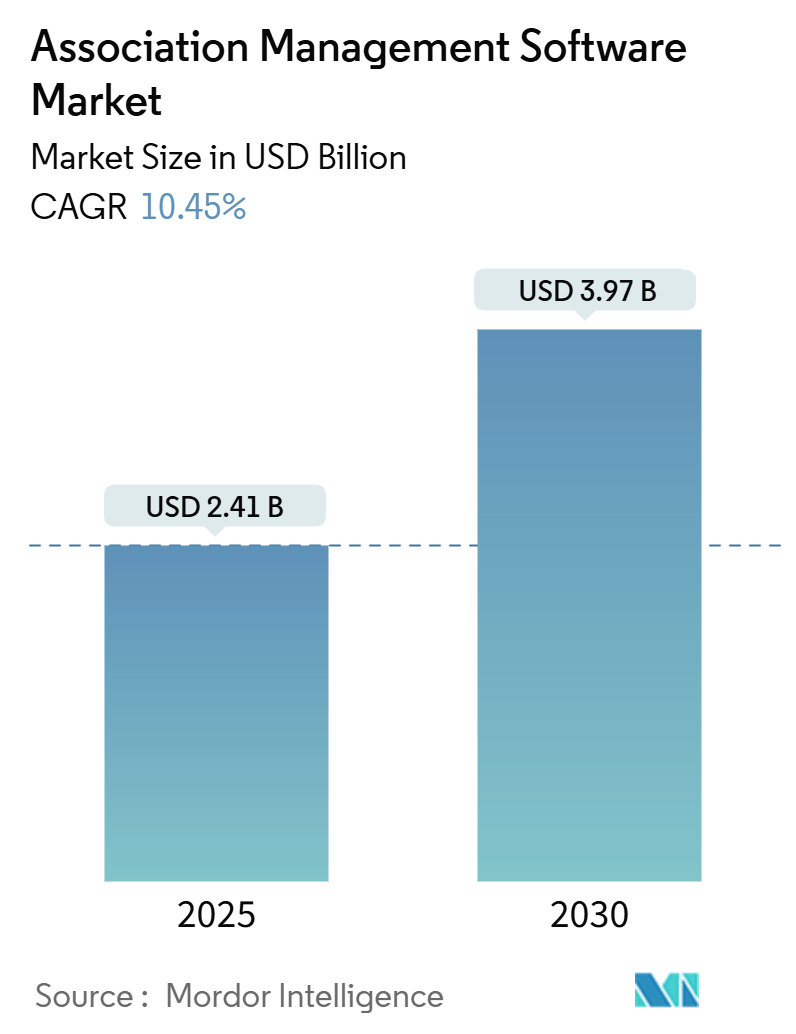
Association Management Software Market Analysis by Mordor Intelligence
The association management software market is valued at USD 2.41 billion in 2025 and is projected to reach USD 3.97 billion by 2030, reflecting a 10.45% CAGR. This growth stems from the rapid shift to cloud-native platforms, sustained subscription uptake, and rising demand for data-driven member engagement solutions. Investor-led consolidation, exemplified by Valsoft Corporation’s 2025 acquisitions, is reshaping competitive dynamics and encouraging one-stop solution portfolios[1]Valsoft Corporation, “Valsoft Acquires UnionWare and MemberTrak,” valsoftcorp.com. Vendors that embed artificial intelligence, open APIs, and vertical-specific templates are attracting both enterprise associations and resource-constrained SMEs. Simultaneously, implementation complexity increases the need for professional services, creating parallel revenue streams and reinforcing vendor–client partnerships. Headwinds include migration risk, data-sovereignty compliance, and a widening skills gap in low-code customization, but these challenges also create entry points for vendors providing managed transformation services.
Key Report Takeaways
- By deployment type, cloud-based solutions held 73.1% of association management software market share in 2024; services linked to cloud adoption are advancing at a 13.8% CAGR through 2030.
- By organization size, SMEs accounted for 56.9% of the association management software market size in 2024, while large enterprises record an 11.2% CAGR as they pursue deeper analytics integration.
- By component, software platforms contributed 81.1% of 2024 revenue; the services segment is forecast to expand at a market-leading 13.8% CAGR to 2030.
- By association type, professional associations led with 33.2% revenue share in 2024; sports and recreation clubs show the fastest growth, advancing at 12.5% CAGR through 2030.
- By geography, North America maintained a 45.6% revenue share in 2024, whereas Asia-Pacific is projected to register the highest 13.1% CAGR between 2025 and 2030.
Global Association Management Software Market Trends and Insights
Drivers Impact Analysis
| Driver | (~) % Impact on CAGR Forecast | Geographic Relevance | Impact Timeline |
|---|---|---|---|
| Market consolidation and demand for one-stop AMS | +2.1% | North America and Europe | Medium term (2-4 years) |
| Cloud-first subscription adoption | +2.8% | Global, strong in Asia-Pacific | Short term (≤ 2 years) |
| AI-driven personalization and analytics | +1.9% | North America and Europe | Medium term (2-4 years) |
| Rising member-experience expectations | +1.7% | Developed markets | Short term (≤ 2 years) |
| Open-API ecosystems and app marketplaces | +1.4% | Tech-forward regions | Long term (≥ 4 years) |
| Vertical-specific AMS templates | +1.6% | Asia-Pacific SMEs | Medium term (2-4 years) |
| Source: Mordor Intelligence | |||
Cloud-first subscription adoption accelerates digital transformation
Subscription models now underpin 73.1% of 2024 deployments and are expanding at 12.4% CAGR, enabling resource-constrained associations to forego capital expenditure without sacrificing enterprise-grade capabilities. Wild Apricot’s cloud-native platform serves more than 25,000 organizations by automating renewals, payment processing, and communication workflows, demonstrating scalable economics. Continuous feature releases, security patches, and pay-as-you-grow pricing collectively support agile operations and regulatory compliance. Associations are therefore prioritizing cloud migration to reduce infrastructure overhead, expand hybrid-work accessibility, and adopt AI-powered tools that would be cost-prohibitive on-premise.
AI-driven personalization transforms member engagement strategies
Artificial intelligence has evolved beyond process automation to deliver dynamic content, predictive lapse scoring, and tailored event recommendations. The American Geophysical Union’s “Rex” engine lifted early-career engagement by 20% through behavior-based content curation. Community Brands embedded Nimble Intelligence into its platform in May 2024, making predictive analytics a standard feature rather than a costly add-on[2]Community Brands, “Nimble Intelligence Launch Announcement,” communitybrands.com. Associations employing AI report higher retention, more targeted sponsorship opportunities, and data-validated program design, creating clear ROI benchmarks that reinforce adoption momentum.
Market consolidation drives one-stop solution demand
Private-equity-backed roll-ups are knitting together member management, event planning, and financial modules under single vendors. Valsoft Corporation’s 2025 purchase of UnionWare and MemberTrak illustrates how scale economics and cross-sell synergies are redefining vendor selection criteria. Associations gain unified data models and simplified vendor management, while acquirers secure sticky recurring revenue. Mid-sized associations, lacking large IT teams, gravitate toward consolidated suites that reduce integration cost and lower vendor-related risk.
Vertical-specific templates accelerate SME uptake
SportsPlus, designed for youth sports governing bodies, offers pre-built registration, scheduling, and payment modules that cut implementation timelines to weeks. Metaps Payment’s Kaihi Pay surpassed 10,000 installations across Japanese gyms, schools, and community groups, proving that vertical templates resonate in diverse settings. Template-driven approaches allow SMEs—already 56.9% of the market—to launch fully functional systems without extensive custom coding, thereby democratizing digital transformation.
Restraints Impact Analysis
| Restraint | (~) % Impact on CAGR Forecast | Geographic Relevance | Impact Timeline |
|---|---|---|---|
| Legacy on-premises migration risks | -1.8% | Established markets | Short term (≤ 2 years) |
| Data-sovereignty and privacy compliance | -1.2% | Europe, North America, Asia-Pacific | Medium term (2-4 years) |
| Functional overlap with CRM/ERP suites | -0.9% | Global enterprise segment | Long term (≥ 4 years) |
| Skills gap in low-code AMS customization | -1.1% | Emerging markets | Medium term (2-4 years) |
| Source: Mordor Intelligence | |||
Legacy on-premise migration risks create implementation barriers
Associations entrenched in customized on-premise systems face 12–18-month transition projects that impose parallel system costs and data-migration complexity. Wild Apricot addresses these concerns by emphasizing data ownership and easy export, yet the fear of workflow disruption slows procurement cycles. Large professional bodies with decades of archival data are particularly cautious, prolonging pilots and demanding extensive testing protocols that extend sales cycles.
Skills gap in low-code customization limits platform optimization
Low-code tools theoretically empower non-technical staff, but effective use still requires knowledge of data structures, API calls, and workflow logic. Join It responds with simplified UI presets, yet many associations lack dedicated resources to exploit platform breadth. Under-utilized modules lead to missed efficiency gains, reinforcing demand for implementation partners and managed services that can bridge the competence gap.
Segment Analysis
By Deployment: Cloud preference redefines infrastructure modernization.
Cloud solutions comprised 73.1% of 2024 revenue, and this share is forecast to climb given a 12.4% CAGR driven by cost optimization and remote-access imperatives. The association management software market size for cloud deployments is projected to rise in tandem with heightened cybersecurity postures and maturing compliance frameworks. Demand spikes during recent operational disruptions established a permanent preference for browser-based work environments. Associations recognize that cloud platforms unlock AI modules, real-time collaboration, and elasticity that on-premise stacks struggle to match.
On-premise deployments maintain a niche presence among entities with stringent data-residency mandates, yet even these organizations are exploring hybrid configurations. Vendors now tout FedRAMP, ISO 27001, and GDPR-aligned features to counter lingering security perceptions. Meanwhile, total cost-of-ownership analyses increasingly favor cloud when factoring patch management and hardware refresh cycles. As broadband availability expands, especially in APAC and Latin America, cloud adoption is expected to penetrate mid-tier and smaller associations that previously lacked reliable connectivity.
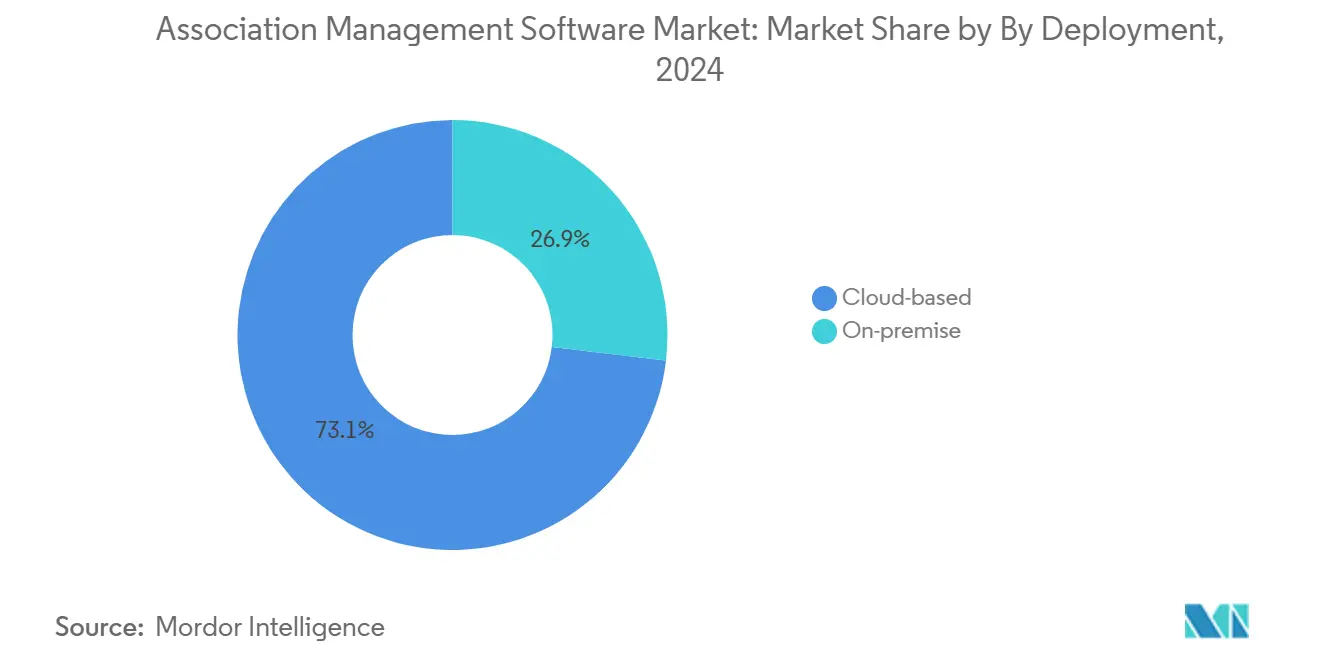
By Organization Size: SMEs propel market democratization
SMEs contributed 56.9% revenue in 2024, reflecting their outsized adoption of templates, subscription billing, and mobile-first modules. The segment records an 11.2% CAGR because subscription pricing aligns with operational budgets and avoids heavy upfront investment, allowing quick procurement approvals. SportsPlus and similar vendors focus product roadmaps on reducing administrator workload, appealing to part-time volunteers typical in SME environments.
Large enterprises continue to drive innovation, pushing for SSO, deep CRM/ERP integrations, and multi-currency support. Their pilot budgets, while smaller in number, influence feature development that eventually filters downmarket. Consequently, the association management software market share for SMEs is expected to remain dominant, yet platform capabilities will increasingly reflect requirements originally articulated by larger organizations, closing the functionality gap between tiers.
By Component: Services growth mirrors implementation complexity
Software remained the primary revenue contributor at 81.1% in 2024, yet service-linked revenue is climbing faster at a 13.8% CAGR. The association management software market size is tied to implementation, data migration, and training services, expanding as platforms evolve from simple record-keeping to multi-module ecosystems. Specialized partners handle integration with CRMs, payment gateways, and learning-management systems, ensuring data flow coherence.
Recurring managed services also address the skills gap, offering routine optimization, analytics tuning, and regulatory audits. Vendors see strategic value in bundling professional services with long multi-year contracts, improving retention and reducing churn. Customers benefit through accelerated time-to-value and reduced risk, reinforcing a mutually beneficial engagement cycle.
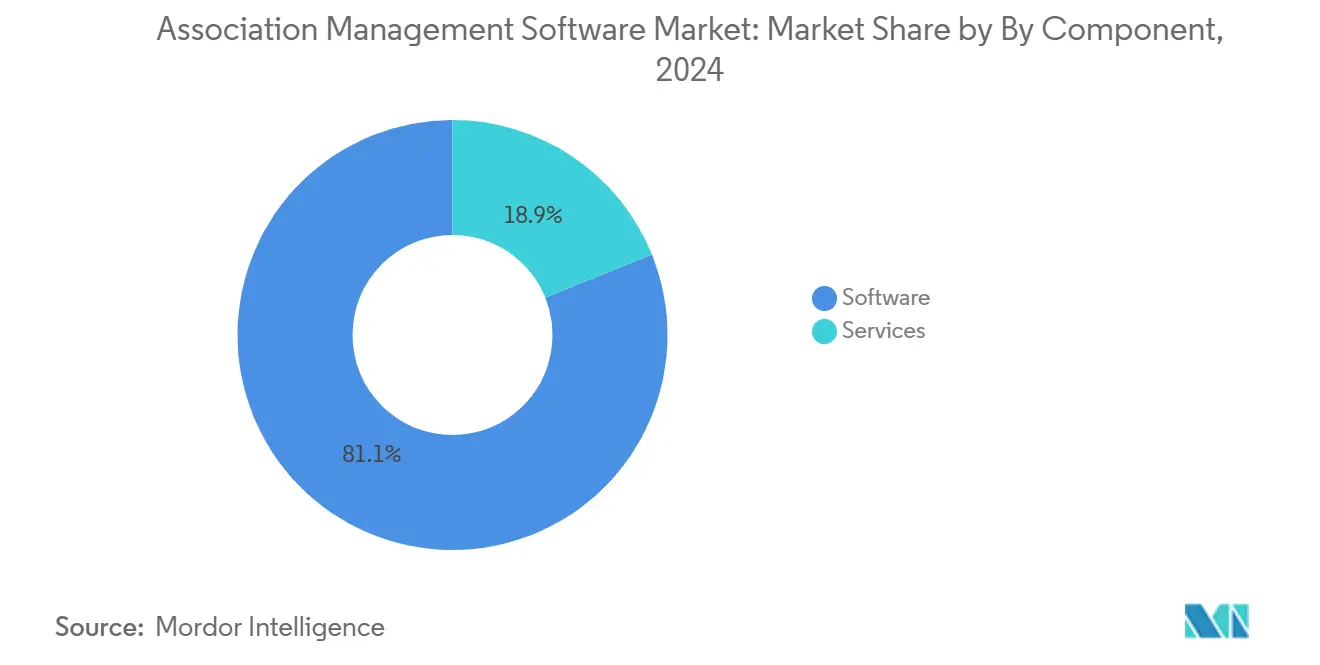
By Association Type: Professional bodies lead digital adoption
Professional and trade associations accounted for 33.2% of 2024 revenue, driven by certification tracking, continuing-education management, and robust networking demands. High member expectations for personalized content and accredited learning drive adoption of AI modules and micro-credential workflows. The association management software market size for professional bodies will continue to expand as regulatory agencies tighten reporting standards.
Sports and recreation groups deliver the highest 12.5% CAGR owing to mobile score-keeping, event calendars, and youth-safety compliance. Non-profits leverage donor management plugins that blend fundraising and membership operations. Faith-based entities, although smaller, are gradually modernizing via multi-campus coordination tools that support hybrid worship formats. This diversity underscores the need for configurable data models capable of handling dues, donations, and event fees within a single system.
Geography Analysis
North America’s 45.6% 2024 revenue share is anchored by early SaaS adoption, a dense vendor ecosystem, and established best-practice frameworks. The U.S. and Canada possess high credit-card penetration and mature payment processors, facilitating seamless dues collection. Growth is trending toward smaller associations that previously relied on spreadsheets; vendors are tailoring starter versions to appeal to this untapped cohort. Competitive differentiation emphasizes advanced analytics, as large associations already view baseline workflows as commoditized.
Asia-Pacific’s 13.1% CAGR through 2030 positions it as the fastest-growing region. Government digitization drives, smartphone ubiquity, and rising professional-body formation feed demand for localized, mobile-friendly applications. Metaps Payment’s Kaihi Pay rollout past 10,000 installations in Japan illustrates product-market fit for integrated payment and membership features[3]Metaps Payment, “Kaihi Pay Milestone Release,” metaps-payment.com. In China, Glue Up’s Mandarin interface addresses linguistic and compliance hurdles. India’s expanding skilled-workforce associations and Southeast Asia’s regional trade bodies further elevate cross-border feature requirements such as multi-currency billing and time-zone-aware event scheduling.
Europe grows steadily, buoyed by GDPR-driven data-governance obligations that elevate compliant cloud vendors. Nordic nations show near-universal digital adoption, whereas Southern Europe’s SME-heavy association base is entering replacement cycles for legacy software. Brexit complexity necessitates solutions that manage dual regulatory regimes, spurring adoption among UK-based associations that operate across continental borders. Multilingual capabilities and on-platform consent management are non-negotiable procurement criteria. South America, the Middle East, and Africa remain nascent but promising; infrastructure improvements and regional professionalization indicate long-term upside despite near-term currency volatility and varied internet reliability.
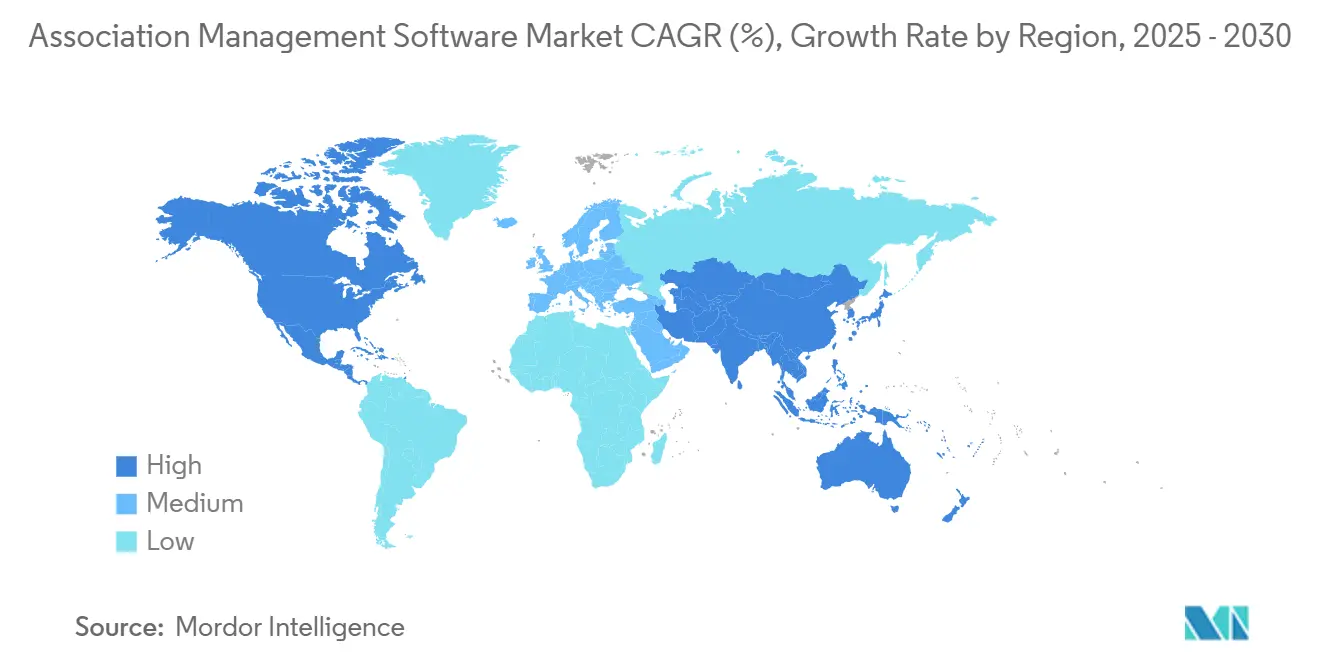
Competitive Landscape
The market remains moderately fragmented; no single vendor exceeds a double-digit share, yet consolidation momentum is undeniable. Valsoft Corporation’s April 2025 acquisitions of UnionWare and MemberTrak underline private equity’s appetite for predictable subscription revenue and cross-sell potential. Community Brands secures breadth through AI-enhanced suites, while startups differentiate via elegant UIs and API marketplaces.
Technology race lines up around artificial intelligence, integration agility, and vertical templates. Community Brands’ Nimble Intelligence embeds predictive analytics natively, countering standalone BI tools. Personify’s 2024 AI reporting engine further raises analytics expectations. Vendors unable to surface actionable insights risk commoditization.
White-space opportunities lie in faith-based, healthcare-adjacent, and pan-regional associations needing multilingual features. Strategic partnerships—such as Glue Up and ASAE—accelerate credibility and channel access. Competitive advantage now centers on outcome metrics: improved retention, smoother onboarding, and event revenue uplift. Vendors providing transparent ROI calculations secure longer contracts and higher NPS scores.
Association Management Software Industry Leaders
-
GrowthZone
-
enSYNC Corporation
-
YourMembership
-
Daxko, LLC
-
Fonteva, Inc.
- *Disclaimer: Major Players sorted in no particular order
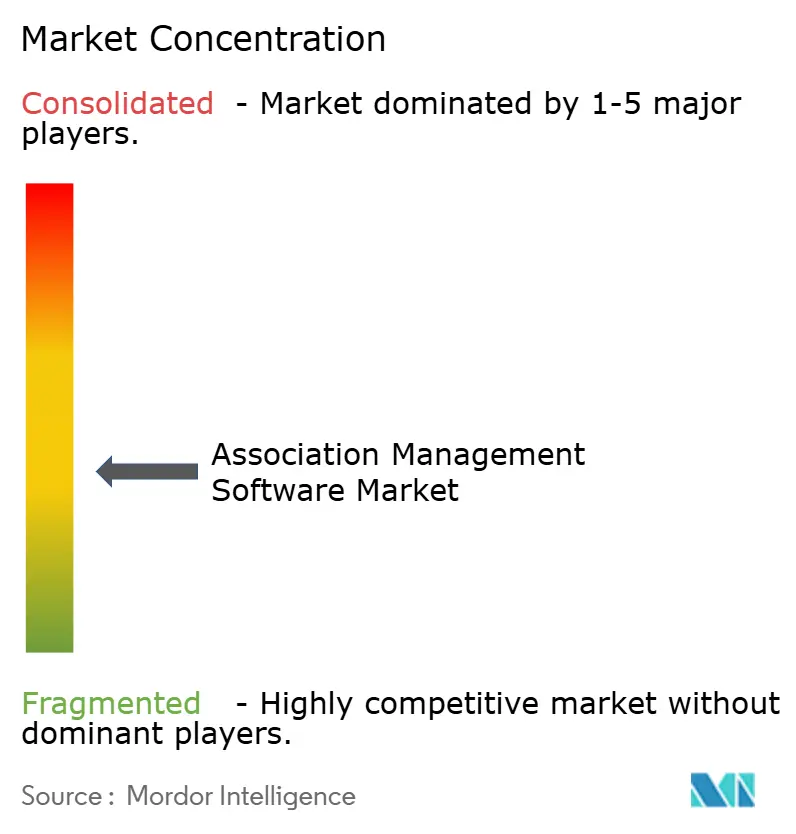
Recent Industry Developments
- April 2025: Valsoft Corporation completed acquisitions of UnionWare and MemberTrak, expanding its AMS portfolio.
- April 2025: Metaps Payment announced Kaihi Pay exceeded 10,000 installations across Japan.
- February 2025: GrowthZone received investment from Lead Edge Capital to scale product development.
- January 2025: Cvent rolled out AI writing assistants and predictive modeling for event professionals.
Global Association Management Software Market Report Scope
The study tracks the revenues accrued through the subscription-based sale of the association management software globally.
Association management software market is segmented by deployment (cloud-based and on-premise), organization size (large enterprises and SMEs), and geography (North America, Europe, Asia Pacific, Latin America, Middle East, and Africa). The market sizes and forecasts are provided in terms of value (USD) for all the above segments.
| Cloud-based |
| On-premise |
| SMEs |
| Large Enterprises |
| Software / Platform |
| Services |
| Professional / Trade Associations |
| Non-profits and NGOs |
| Faith-based / Charitable Groups |
| Sports and Recreation Clubs |
| North America | United States | |
| Canada | ||
| Mexico | ||
| South America | Brazil | |
| Argentina | ||
| Rest of South America | ||
| Europe | United Kingdom | |
| Germany | ||
| France | ||
| Italy | ||
| Spain | ||
| Nordics | ||
| Rest of Europe | ||
| Middle East and Africa | Middle East | Saudi Arabia |
| United Arab Emirates | ||
| Turkey | ||
| Rest of Middle East | ||
| Africa | South Africa | |
| Egypt | ||
| Nigeria | ||
| Rest of Africa | ||
| Asia-Pacific | China | |
| India | ||
| Japan | ||
| South Korea | ||
| ASEAN | ||
| Australia | ||
| New Zealand | ||
| Rest of Asia-Pacific | ||
| By Deployment | Cloud-based | ||
| On-premise | |||
| By Organization Size | SMEs | ||
| Large Enterprises | |||
| By Component | Software / Platform | ||
| Services | |||
| By Association Type | Professional / Trade Associations | ||
| Non-profits and NGOs | |||
| Faith-based / Charitable Groups | |||
| Sports and Recreation Clubs | |||
| By Geography | North America | United States | |
| Canada | |||
| Mexico | |||
| South America | Brazil | ||
| Argentina | |||
| Rest of South America | |||
| Europe | United Kingdom | ||
| Germany | |||
| France | |||
| Italy | |||
| Spain | |||
| Nordics | |||
| Rest of Europe | |||
| Middle East and Africa | Middle East | Saudi Arabia | |
| United Arab Emirates | |||
| Turkey | |||
| Rest of Middle East | |||
| Africa | South Africa | ||
| Egypt | |||
| Nigeria | |||
| Rest of Africa | |||
| Asia-Pacific | China | ||
| India | |||
| Japan | |||
| South Korea | |||
| ASEAN | |||
| Australia | |||
| New Zealand | |||
| Rest of Asia-Pacific | |||
Key Questions Answered in the Report
What is the current size of the association management software market?
The market stands at USD 2.41 billion in 2025 and is forecast to reach USD 3.97 billion by 2030 at a 10.45% CAGR.
Which deployment model dominates the association management software market?
Cloud-based platforms held 73.1% of 2024 revenue and are expanding at 12.4% CAGR as associations favor subscription pricing and remote accessibility.
Why are services growing faster than software licenses?
Implementation, data-migration, and optimization services carry a 13.8% CAGR because associations require specialized expertise to unlock full platform value.
Which region offers the highest growth opportunity?
Asia-Pacific is projected to record a 13.1% CAGR through 2030 thanks to digital-government initiatives, rising association formation, and mobile-first member engagement.
How is artificial intelligence impacting association management platforms?
AI modules such as predictive lapse scoring and personalized content recommendations improve retention and engagement, making analytics a core purchase criterion.
Page last updated on:
